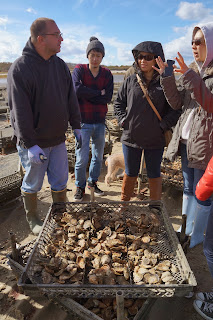One of the points, we reiterate often to the Massachusetts regulatory authorities is that the Commonwealth is leaving money on the table by not embracing oyster restoration. Here a community of 5000 has tapped the Federal Government for half a million for living shorelines including oyster reef. Massachusetts has 192 miles of coastline. If the scientists reporting rising seas and increased storm intensity are correct, we should not be sitting idly by and letting this opportunity to better prepare our coastal areas slip away.
ASSATEAGUE — The U.S. Fish and Wildlife Service and local partners are poised to receive and invest $553,425 in the construction of two living shoreline projects and two acres of oyster reef on Chincoteague National Wildlife Refuge that will help restore and rebuild the Refuge from impacts associated with Hurricane Sandy.
 |
| Map of Northern Virginia highlighting Chincoteague |
This was confirmed in a recent announcement by the Secretary of Interior Sally Jewell, who stated that $162 million will be invested in 45 restoration and research projects that will better protect Atlantic coast communities from powerful storms, by restoring marshes, wetlands and beaches, rebuilding shorelines, and researching the impacts and modeling mitigation of storm surge impacts.
At Chincoteague National Wildlife Refuge, located on the Virginia end of Assateague Island, portions of both the Beach Road and the Service Road were extensively impacted by the storm surge and wave energy associated with Sandy and nearly washed out.
The loss of these roads would impact both the tourism associated with access to the ocean beach and the Service’s ability to manage the natural resources on the Refuge.
“This project provides a terrific opportunity to help protect and increase the long-term resilience of both productive natural systems and man-made infrastructure in the face of climate change impacts at Chincoteague National Wildlife Refuge. Living shorelines and oyster restoration work for both people and nature and are truly a 'win-win' approach to climate change adaptation,” said Steve Parker, Director of The Nature Conservancy’s Virginia Coast Reserve.
“The Conservancy is very excited to work with the U.S. Fish and Wildlife Service, the National Park Service, the Virginia Marine Resources Commission, and the Virginia Department of Game and Inland Fisheries to increase the resilience of one of America’s most visited, economically important, and beloved National Wildlife Refuges.”
The two living shorelines and the oyster reefs proposed for construction under this project are intended as natural infrastructure that will increase the resiliency and capacity of the Beach Road and the Service Road to withstand future storms with reduced damage.
“In addition, the restored oysters associated with the living shorelines and the oyster reefs will provide ecosystem services such as nutrient removal, uptake of sediments, water filtration, increased water quality and increased biomass in the two coves, and provision of habitat for other marine organisms,” stated Kevin Holcomb, supervisory wildlife biologist at Chincoteague NWR.
The investments are consistent with President Obama’s Hurricane Sandy Rebuilding Task Force Strategy Report and the Administration’s commitment laid out in the Climate Action Plan to build resilience by restoring natural features along shorelines to help better protect communities from future storms. The Department of the Interior has already invested $480 million in Hurricane Sandy response and recovery efforts since the storm hit last October.
An additional $45 million is being invested in assessments, modeling, coastal barrier mapping, and other projects to provide Federal, State, and local land managers and decision makers the information and tools they need to improve resiliency and prepare for future storms.
A Technical Review Panel of ten experts from eight Interior bureaus and the Federal Emergency Management Agency and the National Oceanic and Atmospheric Administration evaluated all 94 submitted projects totaling a requested $541 million.
Using a framework developed by Interior’s Strategic Sciences Group, the panel scored each project within the Sandy impact area based on the ability to strengthen Federal assets and build coastal resilience to withstand future storms. Projects were selected based on their ability to provide measurable restoration outcomes and resilience benefits or useful data or management tools in a short timeframe. A priority was given to projects that will employ youth and veterans.
Jewell also announced that the Department would issue a Request for Proposals on October 29 for an additional $100 million in grant funding under the Hurricane Sandy Coastal Resiliency Competitive Grant Program announced in August. States, local communities, non-profit organizations and other partners can compete for funding for innovative projects under the program, which is being administered by the National Fish and Wildlife Foundation. Information on the competition can be found at http://www.doi.gov/hurricanesandy.
The mission of the U.S. Fish and Wildlife Service is working with others to conserve, protect and enhance fish, wildlife, plants and their habitats for the continuing benefit of the American people. The service is a leader and trusted partner in fish and wildlife conservation, known for scientific excellence, stewardship of lands and natural resources, dedicated professionals and commitment to public service. For more information, visit www.fws.gov.





